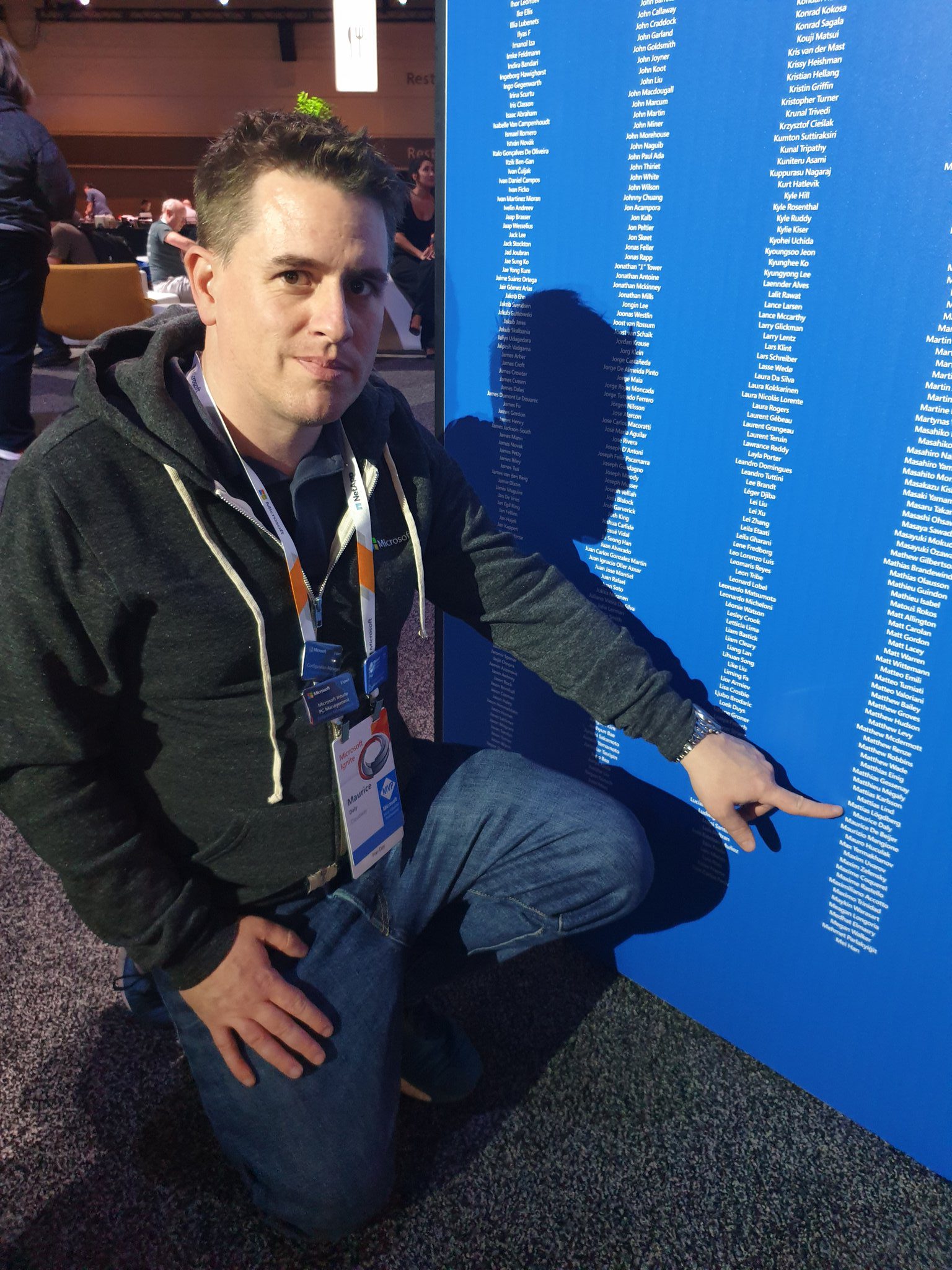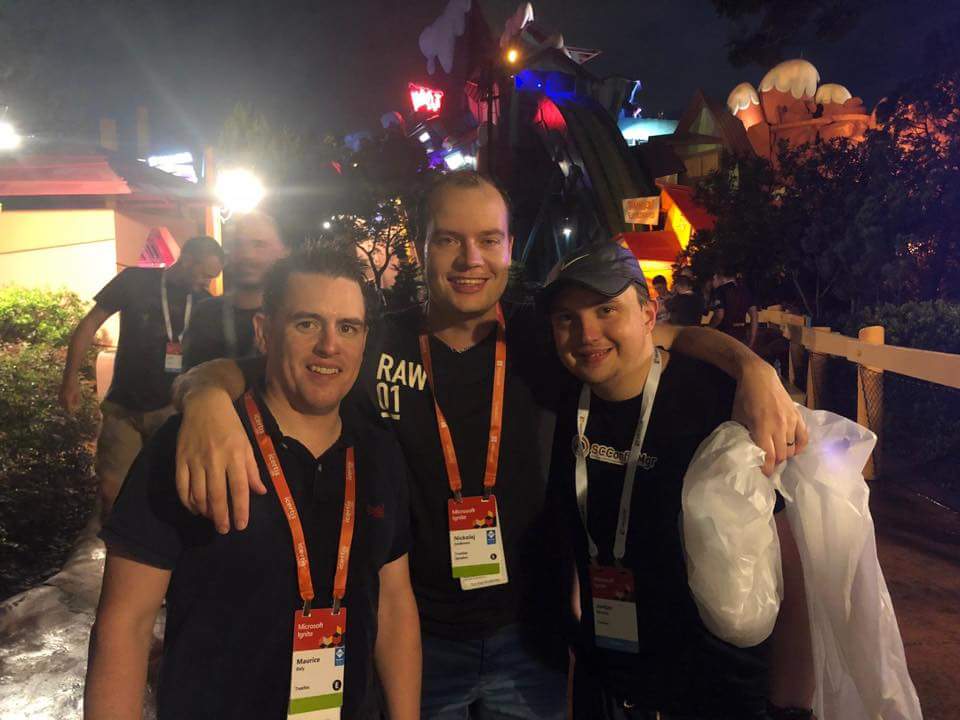The post Q & A with SysAdmin Superstars: Jannik Reinhard appeared first on Recast Software.
]]>In this edition of Q & A with SysAdmin Superstars, we delve into the world of endpoint management and IT security with Enterprise Mobility MVP, Jannik Reinhard. At just 26 years old, Jannik has quickly ascended to the forefront of modern device management and AI-powered IT operations as a Senior Solution Architect and technical lead of AIOPS at BASF, the world’s largest chemical company.
Jannik’s dedication to innovation and knowledge-sharing has positioned him as a pivotal figure in the IT community. Beyond his professional accolades, he contributes significantly to the largest LinkedIn and Discord Intune forums. From his base in Annweiler, Germany, Jannik not only shapes the future of endpoint management at BASF, but also actively engages with a global audience, sharing his expertise, insights, and pioneering solutions. Join us as we explore Jannik Reinhard’s journey, from his early fascination with technology to his status as an MVP, and his vision for the future of IT operations and security.

Paint a picture of your household growing up. Could 10-year-old Jannik imagine your current successes within the Microsoft arena, including your MVP status? Could your family?
From a young age, technology and computers fascinated me, making my career not just my job but my passion. Despite being only 26, I’ve dedicated a decade to IT. Achieving MVP status was beyond my and my parents’ expectations—it was not my initial goal with blogging, yet it’s a milestone I hold in high regard.
Reflecting on your journey, could you share a moment or project that steered you towards specializing in Intune and modern device management? How has this focus shaped your career path?
Since the inception of Microsoft Intune, I was captivated by its potential, even choosing it as the subject of my final educational project. After briefly working in another area, I returned to this field, aiming to delve as deeply as possible into the product and Azure, and to learn as much as I could. I was fortunate to participate in a project where almost all our endpoints were migrated to a cloud-only management system.
With your experience in AIOPS and leveraging AI for IT operations, what strategies would you recommend for SysAdmins to shift from reactive to more proactive operations? How can tools be optimized in this approach?
I envision an increasing role for AI across all sectors in the years ahead, offering boundless potential and opportunities. I also foresee a transformation in device management, for example, with tools like the Security Co-Pilot, as well as changes in how both administrators and users will work in the future. My vision is to achieve a state where the environment is so well automated that problems are detected early and resolved automatically. Additionally, administrators will gain rapid insights that would not be possible without this new technology.
Given your recent work on creating an Intune Co-Pilot using Azure OpenAI Studio and GPT Remediation creator, what do you see as the next (or current) frontier for AI and machine learning in endpoint management and security?
Generally, I see no limits—only more opportunities. I think with the Security CoPilot, Microsoft has launched a very good product that effectively combines their offerings, and this is precisely the potential of AI. There are more and more tools and data available and integrating them will likely be one of the next trends. An administrator should no longer have to search for data sources or identify current problems; the AI should deliver this information directly to them.
From your perspective, what are the most frequent oversights you see organizations make in managing and securing their endpoints? Could you share best practices?
A common oversight is not adopting a cloud-native mindset. I think if you go in the direction of Intune management but can’t separate yourself from the on-premise way of thinking, I see this as a mistake. Of course there is software, devices, requirements that cannot or are not allowed to go into the cloud, but there are solutions for everything.
While your expertise centers on Microsoft technologies, are there any non-Microsoft tools or practices you integrate to enhance endpoint security and management? How do these complement your work with Intune?
I think Microsoft has very good products and answers for most requirements. Of course, the larger an environment, the more requirements there are that cannot always be covered out of the box. Azure presents limitless opportunities for crafting custom solutions to bridge these gaps.
However, there are also some great 3rd party solutions like Recast, Patch my PC, and others on the market. With the Intune Suite, Microsoft also has a good strategy to collect many 3rd party products. I’m generally a fan of the “less is more” philosophy.
What advice would you give to young professionals aiming to excel in IT and potentially earn recognition as an MVP one day?
Find joy in your work. I don’t think it’s good to set the goal of becoming an MVP for yourself and only do community work for that reason. In IT, I think it’s very important to have the right mindset. Always be open to learning new things and to sharing what you’ve learned.
That’s also how I started blogging. My goal was to deal with new things, to write them down so that I can read about them and share them with others.
SysAdmin Superstars Series
Explore our other interviews with SysAdmin Superstars:
- Q & A with SysAdmin Superstars – Prajwal Desai
- Q & A with SysAdmin Superstars – Sami Laiho
- Q & A with SysAdmin Superstars: Jörgen Nilsson
The post Q & A with SysAdmin Superstars: Jannik Reinhard appeared first on Recast Software.
]]>The post Q & A with SysAdmin Superstars: Jörgen Nilsson appeared first on Recast Software.
]]>Jörgen Nilsson is an IT Consultant with Onevinn, working since 1993 in that capacity. He also holds a Microsoft MVP in Enterprise Mobility and blogs at ccmexec.com.
Jörgen is also a Microsoft Certified Trainer and delivers trainings to companies globally, including his self-created Intune – Mobile Device Management training.
In this edition of Q & A with SysAdmin Superstars, we asked Jörgen to share a bit about his history, as well as his recommended priorities for both new and experienced SysAdmins.

Endpoint Management and Security with SysAdmin Superstar Jörgen Nilsson
Paint a picture of your household growing up. Could 10-year-old Jörgen imagine your current successes within the Microsoft arena, including your MVP status? Could your family?
Wow! 10 years old . . . a long time ago. I grew up with an older brother who was 9 years older than me. I always looked up to him, so if he was playing tennis, I was playing tennis. All my free time involved me biking down to play tennis.
At 10 years old, I believe I had a Commodore 64 which initially sparked my interest in computers (I still have my Amiga 500 in original enclosure but the C64 is gone).
What advice do you have for SysAdmins who may feel frustrated by their day-to-day firefighting, wishing they and their company could work more proactively instead of reactively?
Automate and delegate! It is the only way to solve the firefighting and not having enough time dilemma. We are getting more and more tasks to fulfill as SysAdmins with security teams making demands on our time and the world moving faster than ever!
-Automate tasks that can be automated.
-Delegate tasks to the service desk, for example, to save time.
In the last 12 months, what is the most compelling thing you’ve seen come out in the SysAdmin space?
Controlling driver/firmware installs with the WUfB Deployment Service is a huge thing, but it is not available in Intune yet, so it is hard to utilize.
Also, the focus on security topics like privilege management has really taken off, which is great!
For those new to ConfigMgr / SCCM, what advice do you have for them to improve their effectiveness for their organization?
If you are brand new to working with Configuration Manager, take part in a good training. It is one of the most complex products Microsoft has built and it needs to be handled correctly.
What do you feel are some of the most common slip ups organizations make regarding security? How can organizations better approach this security issue?
The biggest challenge is the one mentioned earlier—time. Without time it’s hard to be proactive and increase security.
A fear of making changes that may break end user productivity is also a limiting factor. Defining Deployment rings and using them for all changes is crucial to success.
Time, training, and clear guidance impacts the odds of success. Also, never sit back and relax. The threat actors are always working and never get tired.
SysAdmin Superstars Series
Explore our other interviews with SysAdmin Superstars:
The post Q & A with SysAdmin Superstars: Jörgen Nilsson appeared first on Recast Software.
]]>The post Q & A with SysAdmin Superstars: Sami Laiho appeared first on Recast Software.
]]>For our second Q & A with SysAdmin Superstars, we interviewed Sami Laiho, an 11-time MVP in Windows OS. Sami is a leader in the Privileged Access Management (PAM) space, and specializes in troubleshooting, security, Active Directory, and penetration testing.

Paint a picture of your household growing up. Could 10-year-old Sami imagine your current successes within the Microsoft arena, including your MVP status? Could your family?
IT has been in my life always. My dad used to import and build computers when I was young, so I grew up surrounded by motherboards and memory chips. Ten-year-old Sami was very good with hardware but couldn’t imagine he’d one day be teaching software.
My dad did two things that helped me become successful. First, he got me a summer job as a 16-year-old working for the landlord of PepsiCo. I quickly built a website for them, which I was tasked to do. The speed and quality impressed them enough that they sub-contracted me to PepsiCo. While still 16, I next started consulting with a large NT4.0 environment.
My dad also made me take “those useless Microsoft certificates” that later earned me a job as an IT instructor with Tieturi at the age of 21 – the youngest the company had ever hired.
What advice do you have for SysAdmins working for small to medium-sized businesses who feel frustrated by their day-to-day firefighting, wishing they and their company could work more proactively instead of reactively?
You need two things:
1. Get rid of end user admin rights.
2. Install Application Control, like AppLocker. Once you have Principle of Least Privilege and Application Control concepts implemented, you’ll have time to work more proactively.
You spend a significant amount of your bandwidth advocating for Zero Trust principles. Should Zero Trust be the primary agenda for IT and Security teams regardless of business size? Or are there other bedrock security protocols to solidify before focusing on Zero Trust?
Zero Trust is not all or nothing. Every company, whatever the size, should implement bedrock principles from it, like the Principle of Least Privilege and MFA.
What advice would you have for an administration team running into resistance as they move closer to a Zero Trust environment?
Zero Trust is a bad name. You can rebrand it to “Secure Remote Work Compatibility” or something else like this. Ultimately, Zero Trust aims to make your workplace secure and efficient, whether you are at the corporate office or a Starbucks. I believe every company, large or small, wants this.
What do you feel are some of the most common slip ups organizations make regarding security? How can organizations better approach these issues?
Giving people too many privileges because then “everything just works.” Get a PAM solution and your life will be better.
With Zero Trust being the current trend in security, what do you foresee being the next big wave in InfoSec?
I expect Canary tokens to become a big thing. In the old days, miners used Canaries in mines to monitor air quality, watching to see if the birds passed out due to carbon monoxide. This would raise an alert to get out, protecting the miners. Within the security space, canaries can be tokens, websites, files or other resources that no one is ever supposed to use. If someone touches them, security teams get an alert and security protocols are activated.
With so many “entry level” security jobs requiring years of experience, what advice would you give to someone who is looking to get into the field?
Learn the basics, like Windows Internals. When you have the root knowledge, everything new is easier to learn. Take some programming classes as well. Invest in online learning like Pluralsight.
About Sami Laiho
Sami has been auditing and implementing security solutions since 2002, specializing in Principle of Least Privilege and Application Control. He has deployed solutions for companies ranging from 100 to 550,000 endpoints. He also frequents the Microsoft event circuit as a guest speaker, where he has ranked as the best external presenter by attendees on multiple occasions. Learn more about Sami Laiho.
SysAdmin Superstar Series
Explore our other interviews with SysAdmin Superstars:
The post Q & A with SysAdmin Superstars: Sami Laiho appeared first on Recast Software.
]]>The post Q & A with SysAdmin Superstars: Prajwal Desai appeared first on Recast Software.
]]>This post is the first in a new series, Q & A with SysAdmin Superstars. We’re excited to host Prajwal Desai for our first digital interview. Prajwal is an 8-time MVP in Enterprise Mobility and a vital content creator within the Configuration Manager / SCCM space.

Paint a picture of your household growing up. Could 10-year-old Prajwal imagine your current successes within the Microsoft arena, including your MVP status? Could your family?
I completed my engineering degree in Computer Science and I thought I would be sitting in front of a PC coding one day. Honestly, I lost interest in coding before I completed my engineering degree. I was always interested in Microsoft technologies and my goal was to become an IT administrator one day. I never thought that I would be a MVP until the day I finally got my first MVP award. Since then, I have received 8 MVP awards in Enterprise Mobility. My parents, my wife, and daughter feel so delighted about my achievements.
What energizes you to produce the abundant and valuable content you do? Was there anyone in the tech space who inspired you to start providing content for the IT community?
I started my first job as a Systems Administrator and I always wanted to learn new technologies. I absolutely had no guidance (except Microsoft Documentation) and so I sat down and started learning on my own. The money that I earned was spent on buying a PC with good specs only because I wanted to set up my own lab. Even today I get excited when it comes to learning new topics. Most importantly, once I learn new skills, I want others to learn too and that’s what motivates me to keep sharing my knowledge and experience through my blog.
What advice do you have for SysAdmins who may feel frustrated by their day-to-day firefighting, wishing they and their company could work more proactively instead of reactively?
System Administrators are recognized for their 365 days-a-year work. They are great firefighters who work long hours and weekends. When SysAdmins feel frustrated, they should clearly let the organization know about it. Suggesting tools, showcasing the advantages of these tools, and making improvements to existing processes are some proactive tasks that SysAdmins can initiate from their end. This will help improve the overall situation and benefit the organization too. On the other hand, the SysAdmins should also learn about the tools available in the market that can ease their daily tasks at work.
In the last 12 months, what is the most compelling thing you’ve seen come out in the SysAdmin space?
More focus on Azure / AWS (Cloud Overall), Autopilot, and remote management, rather than walking up to a user and fixing the issues.
For those new to SCCM, what advice do you have for them to improve their effectiveness for their organization?
For beginners in SCCM, know that SCCM / Configuration Manager isn’t going anywhere. There are plenty of resources on the web that teach you how to use SCCM and its features. It’s a good tool to learn and there is a lot of scope for ConfigMgr in today’s IT world. Along with SCCM, put extra effort into learning Azure, Intune, and Microsoft 365, because all these new technologies blend well with SCCM and will add more weight to your resume by showcasing your broader skillset.
Outside of the Microsoft ecosystem, what software tools do you recommend most?
Outside Microsoft, I recommend only the tools that I have used. Some tools that I recommend are:
- Asset Management: Flexera
- Recast Right Click Tools for SCCM: Excellent extension for Configuration Manager
- Patch My PC: Patching third-party applications
- Parallels: Mac management using SCCM
About Prajwal Desai
Prajwal Desai writes at prajwaldesai.com, where he provides content on SCCM, Configuration Manager, Intune, Azure, Windows 11, Windows Server, WordPress Themes and Plugins. He is an 8-time Microsoft MVP in Enterprise Mobility.
SysAdmin Superstars Series
Explore our other interviews with SysAdmin Superstars:
The post Q & A with SysAdmin Superstars: Prajwal Desai appeared first on Recast Software.
]]>The post Recast’s ConfigMgr Community Influencer Highlights – Maurice Daly appeared first on Recast Software.
]]>
Thanks to the efforts of Maurice reaching out to vendors and getting them to publish their catalogs in machine readable formats, many things are now possible for those scripters that wasn’t just years ago. And if you follow Maurice on twitter, you’ll see him calling out vendors when they publish faulty catalogs and getting vendors to improve their own processes. If it wasn’t for Maurice pushing OEMs to create and maintain these catalogs, many of the things I personally have created for work wouldn’t exist.
I’m unsure how many downloads of his tools there are, but I’d imagine it’s quite high. He has taken a difficult process and simplified it, helping admins everywhere take control of drivers and BIOS, and allowing everyone to do it through a simple easy to use interface.
On a personal level, Maurice is an all around great guy. We’ve had several interactions via twitter over the years, and run into each other in person at user groups and MMS, its always an absolute pleasure to chat and hang out.
The Interview:
———————————-
What was your drive for creating the Driver Automation Tool, was it personal, professional or other modifications behind it?
Developing the script that ultimately became the “Driver Automation Tool” was just something that started off as a personal goal for me within my role as a systems admin. At the time I was managing an estate of several hundred machines, quite small in the grand scheme of things, but I had a goal to keep client machines up to date with the latest drivers and BIOS releases. I suppose this goal stems back from when I used to work with an OEM and found that simply deploying and ignoring these updates was something that could lead to instability and cause me a bigger headache down the line. The monotonous monthly cycle of downloading, importing, distributing, and deploying these updates became a bit of a chore. At the time I was also starting to play around with PowerShell scripting, so I thought I would look at how I might automate some of this process for my own gain. Initially I discovered I could parse websites, obtain links, and automate the download process, which I thought was a good start, but I wanted to go further. Adding more and more lines of code, I was then able to automate the process of importing the packages, and distributing them to the DP’s, which was amazing at the time. I could now simply kick off a script and come back the next morning to a new fresh set of drivers for all the models in our environment. For me that was an amazing personal achievement. I had created something that saved time for me, allowing me to focus my efforts on other things. At this point it was time to publish the code so people could use it.
Was creating a “Community Tool” a goal?
To be honest, initially no, I just wanted to share what I had done. Then this thing kind of just grew legs all by itself. I posted the initial command line based solution online on the now sadly defunct Microsoft TechNet, and soon after it started to get a fair bit of traction, but I thought the script based solution might not be for everyone if this was going to become something that everyone could use. Lets face it, the majority of us were forced away from the command line to UI’s in our career, and if you are in that generation of engineer, being forced back to the command line via PowerShell was something that many did not want to embrace. I set about converting the code into a UI, and ultimately published the first release which I called the “Dell Driver Tool”. Publishing this on TechNet generated a lot of traffic, in fact within a couple of days I was contacted by Warren Byle (@WarrenByle) in Dell, asking politely if the Dell logo could be removed from the UI as they had been receiving calls on how to use the tool. Not wanting to invoke any legal issues, I VERY quickly obliged. The next step was to support more OEM’s, so through Twitter I started building up lists of contacts who worked within these large corporations but were so willing to help. These include Nathan Kofahl (@nkofahl) from HP, Joe Parker (@joe_lenovo) from Lenovo, and Carl Luberti (@CarlLuberti)from Microsoft. Over the years it has changed from being several separate OEM tools, to an all inclusive one today, and I learned a lot during the process. Sure if I was to start over again, I would write a lot of the code differently, but it does its job and over the years I have moved away from parsing websites (thank you Gary Blok for giving me that push), I have added more and more features, and I am always trying to refine it (when time permits given an ever busier work and family life)
What is the feature in the tool you are most proud of?
For me it wasn’t so much features within the tool that I am proud of, OK I am proud of a lot of the UI elements as that took time, but to me it’s the fact that the development of the tool lead to OEM’s developing XML catalogues which initially were used within the tool and now are used within their own product sets. That to me is amazing that community contribution can drive development for tools which then extend the capabilities of Configuration Manager and other products.
How did other members of the community influence you, and help you add more features?
When I started off by looking up to those in the Configuration Manager online community, most of which was happening on Twitter, and discovered a mind-blowing list of people who were putting solutions together to help automate things. Individuals like Kim Oppalfens (@TheWMIGuy), Mike Terrill (@miketerrill) and Johan Arwidmark (@jarwidmark) were putting down solutions which I was starting to consume. The tool really came into its own though when I got together with Nickolaj Andersen (@NickolajA) and we started creating a deployment script based solution with a web service back end, effectively creating an end to end automation process that was a single line within your task sequence. I am sure Nickolaj would agree with me that we never intended for it to use up so many hours over the years, but it was been something we have been passionate about for the community.
Any developments on the horizon you can share?
Recently the deployment scripts have been re-written to support the AdminService, and there has been a bunch of additions for compression options. The one thing I am going to focus on for the next release is providing is porting the solution to Intune, and getting through the list of feature requests that are building up on GitHub. I do though see a point where much of what has been done in this whole area becomes a more native function, this might take time, and its great to see white papers coming out on what this might look like from the OEM’s. Until then I’ll keep posting updates and supporting those using the solution.
Any final thoughts or comments?
I must say a massive thank you to everyone who has contributed over the years. The configuration manager community online is quite unique I believe, as we are all willing to share ideas, solutions, and help those in Microsoft who develop the product we love.
———————————-
As Maurice mentions, this is a unique community to be a part of, so helpful, willing to share, and genuinely wants to help lift each other up. I’ve added twitter names to the folks Maurice name dropped, and if you don’t already follow them, you should do so right after you finish reading this. Thanks Maurice for taking time to answer a few questions and provide a glimpse into how some of our favorite tools came into being.
-Gary Blok

The post Recast’s ConfigMgr Community Influencer Highlights – Maurice Daly appeared first on Recast Software.
]]>The post Recast’s ConfigMgr Community Influencer Highlights – Donna Ryan appeared first on Recast Software.
]]>Our ConfigMgr community is absolutely amazing. We have a high level of user group involvement, blogs and websites of plenty, free tools generated in community member’s own personal time, and a world class event born and run by the community. Content being generated continues to grow, even as MS docs and MS Community improves and becomes better each day, which is a testament of the passion our community has to share knowledge, create unique solutions, and build relationships. In this Highlight series, I’ll be covering stories from community influencers who have created tools or process that have greatly impacted the community.
In this first interview, I had the privilege of getting to know Donna Ryan [Twitter], and the ideas behind, and work put into the Community Tool WIM Witch.

Before I get into my interview questions, I just wanted to point how, she’s into StarTrek, and if you follow her on Twitter (which you should), she’s done some pretty cool 3D printing of different starships, which I’m just completely amazed by. Besides her passion for StarTrek which I picked up on, was her cross stitch, which I became aware of at the MMS Jazz event when she donated some of her work for the charity auction. They were pretty hot items on the auction.

Every time I see them, I still get a huge smile and chuckle a little “You have died of dysentery”.. LOL!! Along with the 80004005, every CM Admin needs one of those in their office. Just today I had someone reach out to me asking why their TS Failed with that error code, and I just shook my head. I’ve really enjoyed Donna’s personality in our community as she encourages, and helps to lift spirits in every interaction.
The Interview
What did you do before WimWitch, was it personal, professional, or other motivations behind it?
WIM Witch was my first endeavor into tool creation. Up until I started working on her as a serious project, the largest script I had written was probably 50 lines of code. Everything in WIM Witch had to be learned as I went, which made the first five months of development achingly slow and frustrating.
Prior to starting on WIM Witch, I had a couple of “scripts” that I used when doing image servicing, but my process of image servicing was still mostly a manual process. I had always thought it would be nice to have a simple, graphical tool to remove indexes, appx apps, mount, and dismount images. The name WIM Witch had also been rattling around in the back of my head for years as a cute name for a tool such as this.
What is the feature in WimWitchyou’re most proud of?
Hands down, ConfigMgr integration. To me it is a massive personal milestone to have written something that interacts with a platform like ConfigMgr. What is currently released is only the beginning. I am really looking forward to implementing ConfigMgr console integration as the next major feature set. The update to version 2.2.0 has paved the way for WIM Witch to handle requests from ConfigMgr, and I can’t wait to see what I have sketched out in my head actually in the ConfigMgr console.
What features do you want to enhance or modify?
All of them. The phrase “building the plane as I fly” accurately describes WIM Witch’s development. I have been focused on adding new features to expand her usefulness, and I haven’t had time to go back and update functions with lessons learned. If I had to pick one, languages and FOD’s stick out as the function needing the most revision as the importation process is clunky and the package selection process needs things like a remove button. Unfortunately, there are only so many hours in the day.
How did you get started down this path, what training, blogs, classes prepared you for undertaking this project?
I had no formal training on scripting or programming, just what I learned on the job. The blog that was the most helpful was Stephen Owen’s PowerShell GUI with WPF and XAML. After completing three of the five sections of his tutorial, I had enough knowledge to build a basic GUI and tie it to functions. WIM Witch was actively under development!
There are a couple members that were also instrumental in the development of WIM Witch, and they deserve recognition. I had a ton of help from David Segura of OSDBuilder on dealing with software updates. He spun off OSDUpdate and OSDSUS as independent modules so I wouldn’t have to download OSDBuilder as a whole. I owe a huge debt of gratitude to Dave as I learned a ton about software updates, PowerShell, and WIM Witch wouldn’t be where she is today without. Nickolaj Anderson taught me the basics of WMI and ConfigMgr, and provided a servicing script he had written to serve as a template for WIM Witch’s ConfigMgr software update handling. Most of that function in WIM Witch was built from his script.
There were others that provided guidance, suggestions, and feedback as I worked through her development. WIM Witch is a community tool in the strictest sense as I relied on our community for help, and I am proud to share her with anyone who finds her useful.
What has been some of the coolest experiences for you since publishing WimWitch?
Having someone I greatly respect talk about and demo WIM Witch at a user group in Sweden. I was floored that my little project was being discussed around the world, and by someone whom I hold in the highest regard.
Having technical blog posts and videos created about WIM Witch was mind blowing. That people think that my tool is worth writing and blogging about still amazes me.
I love that I am regularly talking with users from around the world. In the last week alone, I have spoken with people from Australia, Belgium, and Germany.
The best thing has been reading complementary reviews and postings that people have made. My personal favorite is from Reddit. I stumbled across this post by googling WIM Witch:
The simple statement “This just helped my deployment a lot” sums up what I wanted to do with WIM Witch. Help deployments, a lot.
Any advice / words of wisdom to pass on to the community?
If I can do it, you can do it.
Don’t be afraid to ask for help.
Don’t be afraid to give help when asked.
———————————-
I’d like to echo Donna’s advice, don’t be afraid to step out of your comfort zone. We have a very friendly community ready to assist and help you succeed.
This new Influencer highlight series, I’ve setup several interviews with folks in the community who have created items you’ve probably used. Where did they get the idea? What drove them to creating, then sharing it with the community, and what did they learn along the way. I’m excited to share these stories, and I’m hoping you’ll see, that while you might look up to many of these folks in the community, we all started at the same place, and had a desire to learn, grow and share that with others. Please read these and be encouraged to be active in the community and give back. To that end, sites like SysManSquad have been setup for community members to get their feet wet blogging and being coached. Many community members with blogs have also opened up their site for others to post content as well. If you’d like to start contributing, feel free to connect with me on Twitter, and I’ll help to get you connected. Keep checking back, look for our next Community Influencer Highlight post soon!
-Gary Blok
The post Recast’s ConfigMgr Community Influencer Highlights – Donna Ryan appeared first on Recast Software.
]]>


